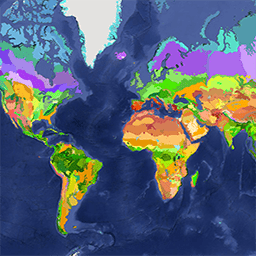
- 数据集可用性
- 2017-04-05T00:00:00Z–2017-04-05T00:00:00Z
- 数据集提供商
- RESOLVE 生物多样性和野生动物解决方案
- 标签
说明
RESOLVE 生态区域数据集于 2017 年更新,描绘了代表我们这个生机勃勃的星球的 846 个陆地生态区域。在 https://ecoregions2017.appspot.com/ 或 Earth Engine 中查看样式化地图。
从最简单的定义来看,生态区域是指具有区域范围的生态系统。具体而言,生态区代表着不同的生物多样性组合(所有类群,而不仅仅是植被),其边界包含维持生态过程所需的空间。生态区域为保护规划提供了一个有用的基础地图,因为它们利用的是自然边界而非政治边界,定义了生物群系内独特的生物地理组合和生态栖息地,并有助于呈现地球的生物多样性。
此数据集基于生物地理学(一门关于动植物分布的科学)的最新进展。自 2001 年推出以来,原始生态区域数据集已被广泛使用,为生态学家对全球气候变化对自然的影响(从世界甲虫的分布到现代保护规划)的最新分析奠定了基础。
846 个陆地生态区分为 14 个生物群落和 8 个界。其中 6 个是森林生物群系,其余 8 个是非森林生物群系。对于森林生物群落,生态区域的地理边界(Dinerstein 等人,2017 年)和保护区(UNEP-WCMC,2016 年)与 2000 年至 2015 年的全球森林变化数据(Hansen 等人,2013 年)相交,以计算保护区内的栖息地百分比和保护区外的剩余栖息地百分比。同样,非森林生态区和保护区(UNEP-WCMC 2016 年)的边界与 2000 年的人为生物群落数据(Anthromes v2)(Ellis 等人,2010 年)来确定保护区内外的剩余栖息地。每个生态区域都有唯一的 ID、面积(平方度)和 NNH(自然需要一半)类别(1-4)。NNH 类别基于保护区内的栖息地百分比和保护区外的剩余栖息地百分比。
- 半保护:超过 50% 的总生态区域面积已受到保护。
- 自然保护区面积可能达到一半:虽然目前受保护的生态区域面积不到总面积的 50%,但如果将新的保护区添加到系统中,剩余的未受保护的自然栖息地面积可能会使受保护的面积超过 50%。
- 自然可能恢复:剩余的受保护和未受保护的自然栖息地面积不到 50%,但超过 20%。此类别中的生态区域需要恢复才能达到“半保护”状态。
- 自然环境岌岌可危:剩余的受保护和未受保护的自然栖息地面积不超过 20%。在短期内实现一半的保护面积是不可能的,因此应侧重于保护剩余的本土栖息地碎片。
更新后的“Ecoregions 2017”是截至 2018 年 2 月,关于每个陆地生态区域剩余栖息地的最新数据集。该报告旨在记录在实现“自然需要一半”这一远大目标方面取得的进展,即保护地球上一半的陆地,以拯救生机勃勃的陆地生物圈。
注意 - 许多生态区域都是非常复杂的多边形,包含超过一百万个顶点,例如岩石和冰。必要时,这些生态区域会进行拆分,同时保留 Eco_ID 等属性。如果您想查看所有已拆分的生态区域,请运行此脚本。
表架构
表架构
| 名称 | 类型 | 说明 |
|---|---|---|
| BIOME_NAME | STRING | 生物群系名称 |
| BIOME_NUM | 双精度 | 群系编号 |
| 颜色 | STRING | 颜色 |
| COLOR_BIO | STRING | 群系颜色 |
| COLOR_NNH | STRING | NNH 颜色 |
| ECO_ID | 双精度 | 生态区域唯一 ID |
| ECO_NAME | STRING | 生态区域名称 |
| 许可 | STRING | CC-BY 4.0 |
| NNH | 双精度 | 根据保护区内的栖息地百分比和保护区外的剩余栖息地百分比确定的 NNH 类别 (1-4) |
| NNH_NAME | STRING | 半保护、自然可达、自然可恢复或自然濒危 |
| OBJECTID | 双精度 | 对象 ID |
| REALM | STRING | 领域名称 |
| SHAPE_AREA | 双精度 | 生态区域多边形的面积(以平方度为单位) |
| SHAPE_LENG | 双精度 | 生态区域多边形的长度(以度为单位) |
使用条款
使用条款
引用
使用 Earth Engine 探索
代码编辑器 (JavaScript)
var ecoRegions = ee.FeatureCollection('RESOLVE/ECOREGIONS/2017'); // patch updated colors var colorUpdates = [ {ECO_ID: 204, COLOR: '#B3493B'}, {ECO_ID: 245, COLOR: '#267400'}, {ECO_ID: 259, COLOR: '#004600'}, {ECO_ID: 286, COLOR: '#82F178'}, {ECO_ID: 316, COLOR: '#E600AA'}, {ECO_ID: 453, COLOR: '#5AA500'}, {ECO_ID: 317, COLOR: '#FDA87F'}, {ECO_ID: 763, COLOR: '#A93800'}, ]; // loop over all other features and create a new style property for styling // later on var ecoRegions = ecoRegions.map(function(f) { var color = f.get('COLOR'); return f.set({style: {color: color, width: 0}}); }); // make styled features for the regions we need to update colors for, // then strip them from the main asset and merge in the new feature for (var i=0; i < colorUpdates.length; i++) { colorUpdates[i].layer = ecoRegions .filterMetadata('ECO_ID','equals',colorUpdates[i].ECO_ID) .map(function(f) { return f.set({style: {color: colorUpdates[i].COLOR, width: 0}}); }); ecoRegions = ecoRegions .filterMetadata('ECO_ID','not_equals',colorUpdates[i].ECO_ID) .merge(colorUpdates[i].layer); } // use style property to color shapes var imageRGB = ecoRegions.style({styleProperty: 'style'}); Map.setCenter(16, 49, 4); Map.addLayer(imageRGB, {}, 'RESOLVE/ECOREGIONS/2017');
以 FeatureView 形式直观呈现
FeatureView 是 FeatureCollection 的只读加速表示形式。如需了解详情,请访问
FeatureView 文档。
代码编辑器 (JavaScript)
var fvLayer = ui.Map.FeatureViewLayer('RESOLVE/ECOREGIONS/2017_FeatureView'); var visParams = { opacity: 1, polygonFillColor: { property: 'NNH_NAME', categories: [ ['Half Protected', 'blue'], ['Nature Could Reach Half Protected', 'green'], ['Nature Could Recover', 'yellow'], ['Nature Imperiled', 'orange'] ], defaultValue: 'lightgrey' } }; fvLayer.setVisParams(visParams); fvLayer.setName('Ecoregions (Nature Needs Half category)'); Map.setCenter(16, 49, 4); Map.add(fvLayer);
